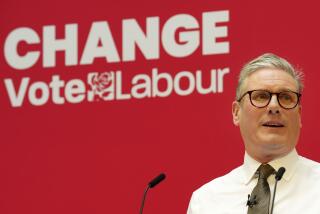10 Years of Thatcher Put Imprint on Tories
- Share via
LONDON — Virtually by accident, Britain’s Conservative Party chose its first woman leader 10 years ago this month.
It seemed a high-risk gamble, yet Margaret Thatcher has forcibly stamped her distinctive style and right-wing views on her party and nation.
Many thought the grocer’s daughter would never survive, that she would be just an interim leader until the defeated party rallied behind a more traditional Tory figure.
“She had nothing going for her,” recalled Fergus Montgomery, one of an initial handful of Conservative legislators who backed Thatcher for the leadership when the party moved to replace Edward Heath, the former prime minister. Heath in 1974 had led the Conservatives to electoral defeat at the hands of Harold Wilson’s Labor Party.
Not From Right Class
“She was an outsider,” Montgomery recalled. “She didn’t come from a landed or aristocratic family. And all the time she was fighting her sex--all those who felt that having a woman was wrong.”
Ten years later, 19 months into her second five-year term as prime minister, Thatcher is reported to be raring to run for a third term--and her sex is one of the few things about her that no longer provokes controversy.
Thatcher, Europe’s first female head of government, is now the longest serving Tory leader since Winston Churchill’s 15-year tenure at the head of the Conservative Party ended in 1955. At 59, she has swung the party away from her predecessors’ attempts at consensus in postwar Britain.
Since she led the Conservatives back to power in May, 1979, on a platform of halting economic and national decline, Britain has, she maintains, “found self-respect at home and found a new respect and admiration abroad.”
Critics Note Unemployment
Critics, including some members of her own party, charge that she has thrown millions out of work as the price of curbing inflation, that she has divided Britain, increased the nuclear threat through hawkish, anti-Soviet policies and given the Conservatives a hard-faced image.
“We are now a divided Britain . . . and the two nations of today are the employed and unemployed,” said former Foreign Secretary Francis Pym, a moderate Tory, whom Thatcher fired from her Cabinet in 1983.
Admirers and opponents agree that, for better or worse, the Conservative Party is not just led by Thatcher, but belongs to her.
Government policy is often described simply as Thatcherism.
“Thatcherism is a personal fixation turned into a system of government . . . (a) combination of ignorance and arrogance, of pride and prejudice,” Labor Party leader Neil Kinnock, her opposite number in the British parliamentary opposition, charged.
Despite rising unemployment, now exceeding 13%, Kinnock’s Laborites, a socialist party, trail the Tories by five percentage points in public opinion poll ratings. The Liberal-Social Democratic Alliance, a left-center coalition partly fashioned from discontented Labor Party moderates, runs third.
Hitting Responsive Note
So Thatcher’s strength reflects both this continued disarray in the British left and also what many commentators see as probably her greatest asset--an ability to strike a chord among Britain’s skilled working classes and middle classes.
Polls show that majorities consider her bossy, dictatorial and right-wing. But she scores points for being perceived as tough, credible and honest.
Thatcher has also had luck. It helped her be elected Conservative leader only six months after she had told a reporter: “It will be years before a woman either leads the party or becomes prime minister. I do not see it happening in my lifetime.”
She had held only one Cabinet post, as Heath’s education secretary from 1970 until the Conservatives lost power in February, 1974.
After another election defeat that October, Tory legislators--who elect the leader--demanded a contest. Sir Keith Joseph, now education secretary under Thatcher, was the acknowledged candidate of the party’s right wing.
But then Joseph made a speech saying that working-class Britons should have fewer children because they relied too heavily on welfare. He withdrew amid a public furor.
Series of Withdrawals
Thatcher stepped in with only a handful of backers. Then, Heath’s main threat, Edward du Cann, a legislator capable of attracting widespread support, withdrew his candidacy for family and business reasons, and his strong campaign team switched to Thatcher.
She topped the first ballot but lacked the required majority. Heath then withdrew, and in a second ballot on Feb. 11, 1975, she won with 146 votes to 79 for her nearest rival, Heath supporter William Whitelaw, the former Cabinet secretary for Northern Ireland.
The pro-Tory Daily Mail, writing of her ascension as party leader, commented: “Historically and politically, it is perhaps the greatest gamble the Conservatives have taken since, in 1868, they swept aside prejudices against Jews to make Benjamin Disraeli their leader.”
Old-style, moderate Tories were shocked, but Nicholas Wapshott, a writer for The Times of London, recalled in a 1983 biography of Thatcher that they she was just a passing phenomenon.
“They thought . . . impulses would derail her and they had only to wait to resume their control of the party,” Wapshott wrote.
Nowadays, Heath scarcely applauds at the end of annual party conferences when the Tory faithful cheer the woman who is Western Europe’s longest serving head of government.
In the intervening hectic years, she has led Britain through the Falkland Islands war against Argentina in 1982 and has survived an Irish Republican Army assassination attempt last October.
More to Read
Sign up for Essential California
The most important California stories and recommendations in your inbox every morning.
You may occasionally receive promotional content from the Los Angeles Times.













